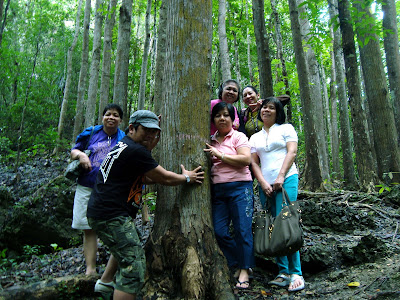Tropical Rainforest Profile
Dr Abe V Rotor

 Rainforest serves as watershed, keeps river full and clean,
Rainforest serves as watershed, keeps river full and clean, creates a cool mini climate in the area, Bohol.
Let us look at the TRF profile like slicing a multi-layered cake and studying its profile. It is made up of storeys similar to a high-rise building. The “roof” or canopy is what we see as forest cover. Here and there are very tall trees called emergents jotting through the monotonous canopy like living towers.
From the air, the view of a tropical forest is one huge and continuous green blanket that catch the energy of the sun and through photosynthesis converts it into organic materials beginning with simple sugar to the most complex compounds from which useful materials are derived - wood, rubber, resin, and drugs, etc. These products are needed to sustain the life of countless organisms and the stability of the ecosystem itself.
From the forest floor, one can see only a little part of the sky, with the rays of the sun filtering through. But now and then, the trees, depending on the species, season and other environmental conditions, shed off their leaves, which can be compared to the molting of animals as they grow. Entire crowns of leaves fall and litter the forest floor. Transformation into humus continuously takes place with the aid of insects, bacteria, fungi, earthworms and the like. And this is very important because humus fertilizes the soil and conserves water acting as sponge and blanket.
This is one of the wonders of nature. Trees in a tropical rainforest have this special characteristic. They are not only self-fertilizing; they are soil builders. Through time, with the deciduous cycle repeated without end, the forest floor – even how thin the soil is, or how solid the underlying rock is – builds up, layer after layer, and it is this process that enables many organisms in the forest obtain their nutrition in order to grow.
Deciduousness allows sunlight to pour over the previously shaded plants occupying the various layers or storeys, which serve as specific habitats or niches. Occupying the lowest part of the forest, which is equivalent to the ground floor of a building, are mostly annuals, ferns and bryophytes. Next are the shrubs which occupy the lobby and second floor, followed by undergrowth trees that reach a height equivalent to the third and fourth floor, lianas and epiphytes which may reach as high as the eighth floor. It is not surprising to find emergent trees reaching up the 200 feet.
How big can a tree grow and for how long? Take the case of the Redwoods or Sequoia found growing in southern California, and China. I saw a tree of this kind in southern Taiwan, recently killed by lightning. The tallest redwood, which is still growing today, is 267.4 feet tall with a trunk diameter of 40.3 feet. It is estimated to be 3,500 years old.
The analogy of the layers of a rainforest with a ten- or twelve-storey building gives us in imagination of the orderliness of nature in keeping the rich biodiversity of the ecosystem.
The true forest primeval – the rain forest – stands along the equator now reduced into a sanctuary of “living fossils” of plants and animals that once constituted the eternal green cover of the earth.
The canopy at one time or another allows the sky to meet the residents of the forest from the ground floor to the upper storeys - something that if you stand among the trees during this transformation you will find a kind of communion that, while it can be explained biologically, fills the spirit with the wonders and mysteries of nature.
The tropical rainforest is a natural menagerie where peace, music, colors, patterns, art and skill are not so well known to modern man. The high-perched artists like squirrels and monkeys are better acrobats by birth and practice than any known human acrobats. Many primates howl with electrifying, ear splitting and blood-chilling sound that breadth the land. Above plummet the masters of the sky – the Philippine eagle and hawks, spotting their preys which may be several kilometers away, or hundreds of meters below – something which our modern spotting scopes can not yet achieve with readiness and precision.
Inside their tunnels the termite workers tap their way and chop the wood for their colony and themselves. Man has yet to learn more about the social structure of this insect. ~


No comments:
Post a Comment